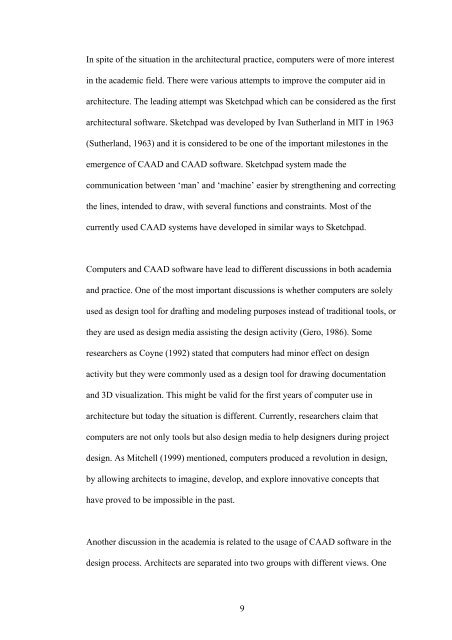critical analysis of the absence of interior - Bilkent University
critical analysis of the absence of interior - Bilkent University
critical analysis of the absence of interior - Bilkent University
Create successful ePaper yourself
Turn your PDF publications into a flip-book with our unique Google optimized e-Paper software.
In spite <strong>of</strong> <strong>the</strong> situation in <strong>the</strong> architectural practice, computers were <strong>of</strong> more interest<br />
in <strong>the</strong> academic field. There were various attempts to improve <strong>the</strong> computer aid in<br />
architecture. The leading attempt was Sketchpad which can be considered as <strong>the</strong> first<br />
architectural s<strong>of</strong>tware. Sketchpad was developed by Ivan Su<strong>the</strong>rland in MIT in 1963<br />
(Su<strong>the</strong>rland, 1963) and it is considered to be one <strong>of</strong> <strong>the</strong> important milestones in <strong>the</strong><br />
emergence <strong>of</strong> CAAD and CAAD s<strong>of</strong>tware. Sketchpad system made <strong>the</strong><br />
communication between ‘man’ and ‘machine’ easier by streng<strong>the</strong>ning and correcting<br />
<strong>the</strong> lines, intended to draw, with several functions and constraints. Most <strong>of</strong> <strong>the</strong><br />
currently used CAAD systems have developed in similar ways to Sketchpad.<br />
Computers and CAAD s<strong>of</strong>tware have lead to different discussions in both academia<br />
and practice. One <strong>of</strong> <strong>the</strong> most important discussions is whe<strong>the</strong>r computers are solely<br />
used as design tool for drafting and modeling purposes instead <strong>of</strong> traditional tools, or<br />
<strong>the</strong>y are used as design media assisting <strong>the</strong> design activity (Gero, 1986). Some<br />
researchers as Coyne (1992) stated that computers had minor effect on design<br />
activity but <strong>the</strong>y were commonly used as a design tool for drawing documentation<br />
and 3D visualization. This might be valid for <strong>the</strong> first years <strong>of</strong> computer use in<br />
architecture but today <strong>the</strong> situation is different. Currently, researchers claim that<br />
computers are not only tools but also design media to help designers during project<br />
design. As Mitchell (1999) mentioned, computers produced a revolution in design,<br />
by allowing architects to imagine, develop, and explore innovative concepts that<br />
have proved to be impossible in <strong>the</strong> past.<br />
Ano<strong>the</strong>r discussion in <strong>the</strong> academia is related to <strong>the</strong> usage <strong>of</strong> CAAD s<strong>of</strong>tware in <strong>the</strong><br />
design process. Architects are separated into two groups with different views. One<br />
9
















